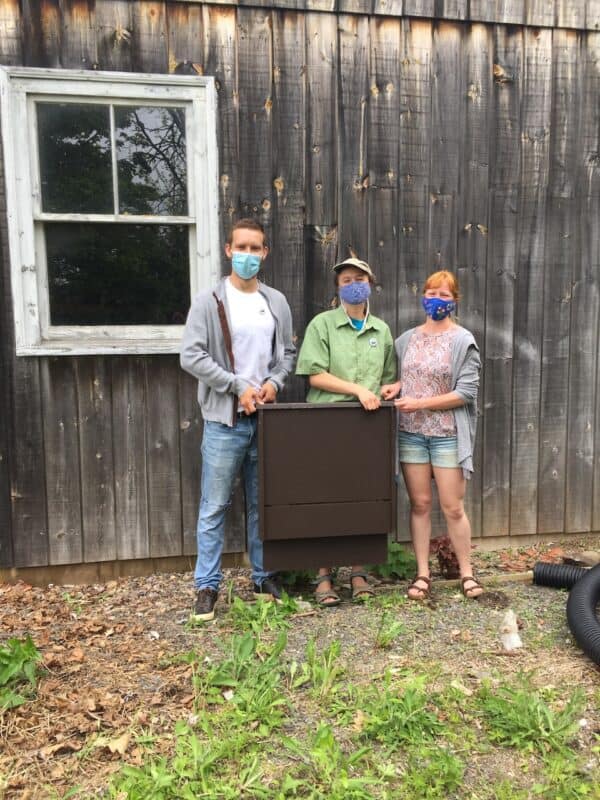
Acadia students are behind a bat box installation that recently took place at the K.C. Irving Environmental Science Centre and Harriet Irving Botanical Gardens. The installation will hopefully bring bats to our Harriet Irving Botanical Gardens and Woodland Trail habitats, but the bat boxes have already brought several Acadia Students together.
Installing a bat box in close proximity to the woodland trails was an idea that student Sarah Lavallee (Bachelor of Community Development, 2022) brought forward during her time as the Woodland Trails Community Intern. Sarah’s friends, Taryn Muldoon (Bachelor of Science, Biology 2023) and Zackery Pate (Bachelor of Environmental Studies, 2022) are the founders of The Annapolis Valley Bat Box Project. Sarah knew this Acadia student team should have the opportunity to install one of their boxes on campus.
The inspiration to begin the Annapolis Valley Bat Box Project came from a review paper that Zackery wrote for a class with Dr. Mary Sweatman. Zackery sent the paper to a friend, and it ended up connecting him to Taryn and then to with the Canadian Wildlife Federation. The CWF pitched the idea for Zackery and Taryn to start a program to engage the local community in bat conservation. Taryn says “we were very excited to start work on a project that combined a tangible way of helping bats with community outreach and education around the challenges bats face”.
The Annapolis Valley Bat Box Project aims to build boxes and provide education to raise empathy for and awareness about bats in Nova Scotia. Bat boxes provide habitat for Nova Scotia’s three resident species of bats: the little brown myotis, northern myotis, and the tri-colored bat, which are all listed as federally endangered due to White Nose Syndrome. White Nose Syndrome is an introduced fungal disease that has decimated North American bat populations. that is estimated to have killed more than 90% of Nova Scotia’s bats between 2011 and 2013. Bat boxes provide safe, clean roosting areas for bats, helping support populations in their recovery. This is an important way to support their re-population and to monitor how their population is changing.
Both Taryn and Zackery emphasize that education is the most important component of their mission. When they needed to increase their capacity for box building, they realized local high schools would be an ideal fit through Tech Ed class. The two prioritized designing educational conservation resources to compliment the construction element. Local high schools are keen to partner, Central Kings, Horton and Northeast Kings High Schools are all at various stages of involvement. Zackery says “our program is a fantastic way to get young minds interested in conservation, while learning practical hands on skills”. Property owners that install bat boxes are also encouraged to learn monitoring skills and participate in citizen science with resources provided by The Annapolis Valley Bat Box Project.
The Annapolis Valley Bat Box Project is also beginning a research project in Greenwood, NS that will assess over 150 bat boxes of three different styles. The boxes will be outfitted with humidity and temperature monitors, as well as infrared cameras to determine which boxes are most effective. This academic research will yield publishable data to contribute to our limited knowledge on bat habitat preferences. Results will help shape future conservation efforts of the Annapolis Valley Bat Project and more broadly to those working in bat conservation. The project is supported by conservation biologists Dr. Steven Cooke of Carleton University, and Dr. Kristen Lear; Acadia Alumni Lori Phinney of Mersey Tobeatic Research Institute; and James Page of the Canadian Wildlife Federation. This research team will also become Board Members as the Annapolis Valley Bat Box Project transitions to a nationally recognized charity in 2021.
Zackery explains the community response to this project has been significant. “After the CBC article and the radio interview, we received an overwhelming amount of support. Some of which we simply have not had the time to get back to! We are working hard to make it happen though, we promise”.
Taryn says “Before this project, I did not know the extent to which Nova Scotians feel the loss of their bats. The response and empathy we have received has been heartwarming. Community members often reach out to us to ask how the bat population is recovering, or to tell us stories of the bat colonies they remember from their childhood. I did not realize the effect white nose syndrome had on those who experienced the loss of the bats first-hand, and seeing the amount of care Nova Scotians have for bats and their conservation has been powerful”.
Both Zackery and Taryn hope to work in conservation after their time at Acadia and feel this project has helped them to solidify their interest in the field. The two say it’s great to see one of their boxes on the Acadia Campus and they hope it can build awareness among the Acadia Community. They have ambitious plans to continue expanding the scope of the Annapolis Valley Bat Box Project with ideas for research, enhancing construction, and community outreach. If you are interested in supporting their work, please email annapolisvalleybats@gmail.com. More information on involvement opportunities can be found here.



 Acadia University
Acadia University